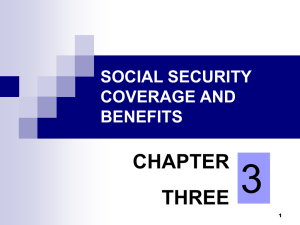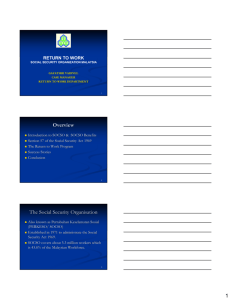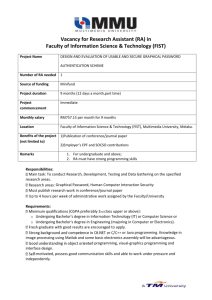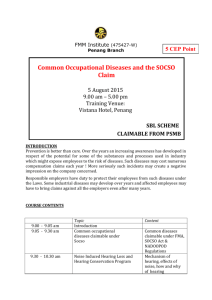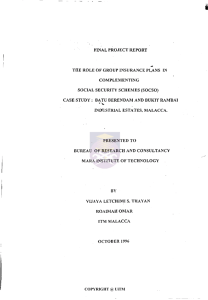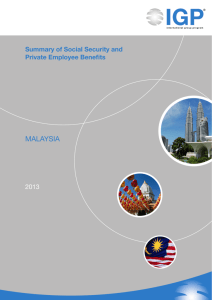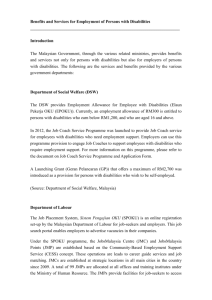IJIBS_04_01_02 - International Business School
advertisement
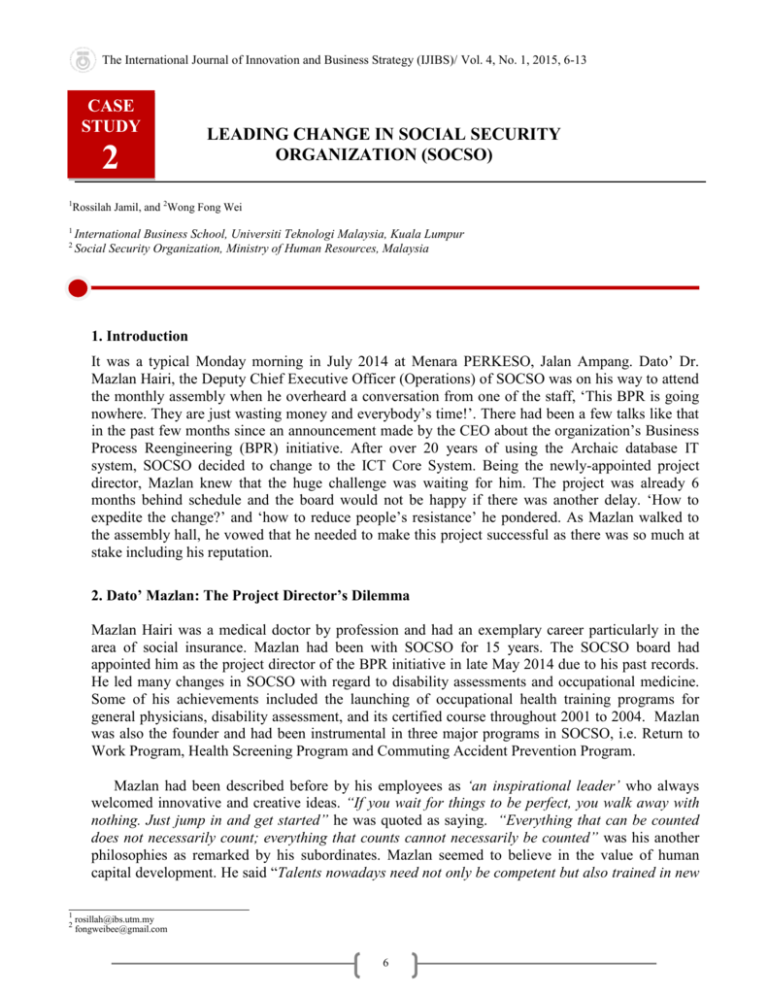
The International Journal of Innovation and Business Strategy (IJIBS)/ Vol. 4, No. 1, 2015, 6-13 CASE STUDY 2 LEADING CHANGE IN SOCIAL SECURITY ORGANIZATION (SOCSO) 1 Rossilah Jamil, and 2Wong Fong Wei 1 2 International Business School, Universiti Teknologi Malaysia, Kuala Lumpur Social Security Organization, Ministry of Human Resources, Malaysia 1. Introduction It was a typical Monday morning in July 2014 at Menara PERKESO, Jalan Ampang. Dato‟ Dr. Mazlan Hairi, the Deputy Chief Executive Officer (Operations) of SOCSO was on his way to attend the monthly assembly when he overheard a conversation from one of the staff, „This BPR is going nowhere. They are just wasting money and everybody‟s time!‟. There had been a few talks like that in the past few months since an announcement made by the CEO about the organization‟s Business Process Reengineering (BPR) initiative. After over 20 years of using the Archaic database IT system, SOCSO decided to change to the ICT Core System. Being the newly-appointed project director, Mazlan knew that the huge challenge was waiting for him. The project was already 6 months behind schedule and the board would not be happy if there was another delay. „How to expedite the change?‟ and „how to reduce people‟s resistance‟ he pondered. As Mazlan walked to the assembly hall, he vowed that he needed to make this project successful as there was so much at stake including his reputation. 2. Dato’ Mazlan: The Project Director’s Dilemma Mazlan Hairi was a medical doctor by profession and had an exemplary career particularly in the area of social insurance. Mazlan had been with SOCSO for 15 years. The SOCSO board had appointed him as the project director of the BPR initiative in late May 2014 due to his past records. He led many changes in SOCSO with regard to disability assessments and occupational medicine. Some of his achievements included the launching of occupational health training programs for general physicians, disability assessment, and its certified course throughout 2001 to 2004. Mazlan was also the founder and had been instrumental in three major programs in SOCSO, i.e. Return to Work Program, Health Screening Program and Commuting Accident Prevention Program. Mazlan had been described before by his employees as „an inspirational leader‟ who always welcomed innovative and creative ideas. “If you wait for things to be perfect, you walk away with nothing. Just jump in and get started” he was quoted as saying. “Everything that can be counted does not necessarily count; everything that counts cannot necessarily be counted” was his another philosophies as remarked by his subordinates. Mazlan seemed to believe in the value of human capital development. He said “Talents nowadays need not only be competent but also trained in new 1 2 rosillah@ibs.utm.my fongweibee@gmail.com 6 The International Journal of Innovation and Business Strategy (IJIBS)/ Vol. 4, No. 1, 2015, 6-13 equipments. This is compounded by the fact that new technologies, systems and policy changes are constantly being introduced in the industry." The BPR project was initially led by an external consultant with a certificate in Project Management Professional (PMP). The firm was replaced when it failed to achieve the first four project milestones. The team blamed it on poor communication, lack of commitment from SOCSO as the reasons for its failure. When Mazlan took over, the project was already 6 months delay. The main challenge for Mazlan was to accelerate the BPR process so that the IT transformation initiative could be put back on track. 3. Background of SOCSO The Social Security Organization (SOCSO) or Pertubuhan Keselamatan Sosial (PERKESO) was an agency under the Malaysian Ministry of Human Resources. Formed in 1971, SOCSO was made responsible to provide and manage social security protection to human capital in Malaysia. Social security refers to protections that a country legally provides to its human capital against disruption and loss of earning capability. Two main laws that governed SOCSO‟s operations were the the Employees' Social Security (General) Regulations (1971) and the Employees' Social Security Act (ESSA) (1969). SOCSO was considered a statutory body on 1st July 1985. Starting 1st January 1992, SOCSO no longer used the government‟s compensation system but could decide on its compensation structure under the New Social Security Protection Scheme (or Sistem Saraan Baru PERKESO (SBBP)). SOCSO had 46 branches or local offices throughout Malaysia with headquarter located at Jalan Ampang, Kuala Lumpur. SOCSO had about 2000 staffs over Malaysia. SOCSO stated its vision as „To become the premier and outstanding leader in social security towards 2020‟. Its policy and client charter are shown in Exhibit 1. SOCSO provided benefits to its members through two types of social security schemes. The Employment Injury Insurance Scheme provided protection to workers from work place injuries, including accidents occurred while workers travelling to their workplaces, and work-related diseases. Under this scheme, the benefits consisted of the Medical Benefit, Temporary Disablement Benefit, Permanent Disablement Benefit, Constant Attendance Allowance, Dependants‟ Benefit, Funeral Benefit, Rehabilitation Benefit, and Education Benefit. On the other hand, the Invalidity Pension Scheme provided around-the-clock protection to workers against invalidity or death. Under this scheme, workers can be eligible for benefits such as Invalidity Pension, Invalidity Grant, Constant Attendance Allowance, Survivors‟ Pension, Funeral Benefit, Rehabilitation Benefit, and Education Benefit. Contributions to SOCSO funds covered both employers and employees. Under the ESSA 1969, all employers with one or more employees were required to register and contribute to SOCSO. With regard to the employees, the law in Malaysia stipulated for those who earned RM3000 or less. Based on the „once-in-always-in‟ principle, individuals who were already registered but whose monthly salaries now exceeded the amount could continue their contributions subject to mutual agreements with their employers. According to SOCSO Annual Report (2013) (Table 1), the number of registered employers in 2013 had increased by 4.98% to 906,363 employers compared to 863,338 in 2012. Similarly, the numbers of registered employers had grown from 14,363,035 in 2012 to 14,876,353 in 2013. 7 The International Journal of Innovation and Business Strategy (IJIBS)/ Vol. 4, No. 1, 2015, 6-13 Table 1: Number of Employers and Employees 2012-2013 Year 2012 2013 Registered 863,338 906,363 Employers Employees Active Registered Active 383,575 14,363,035 5,876,934 393,451 14,876,353 6,089,054 Source: SOCSO Annual Report 2013 The Report also announced that recipients of SOCSO‟s benefits had risen by 72.19% (286,543 recipients) compared to 396,914 in 2012. Benefits expenditure increased by 10% to RM2,222.74 million compared to RM2,020.62 million in 2012. And its total contributions collected in 2013 increased by RM192.82 million or 8.29% to RM2,518.14 million from RM2,325.32 million in 2012. At international level Malaysia‟s social security protection had been subject to scrutiny in its role in minimizing poverty in the country. Lee (2002) proposed that Malaysia needed a more universal social security protection system and to introduce other schemes to better protect workers in the age of economic uncertainty. The SOCSO‟s Chief Executive Officer, Datuk K. Selvarajah, was quoted as saying that there was no plan to review the country‟s social security protection policies given that the positive increased numbers of contributors and issuance of compensations (Utusan Malaysia, 19 th November 2014). 4. Archaic IT System The Archaic database system had been using by SOCSO since 1990s to support its many operations (Exhibit 2). Each of the application was stand alone and stored in different database platforms. Process to claim SOCSO benefits usually involves the contributors to fill in respective forms and submit the required documents to SOCSO office such as attendance records, medical certificates, police reports, and a copy of identity cards. Employers and employees across Malaysia submitted their claims through multiple applications such as SIKAP, Q-Term, Websys, and so on. Employees‟ contributions to SOCSO were processed manually whereby the contributors filled in and submitted their forms to SOCSO offices. SOCSO employees then manually keyed the data into its system. Not only that SOCSO was often unable to cope with the amount of forms given its limited manpower, the manual key in also created a lot of data entry mistakes. The IT system was still heavily dependent to paper-based files. This resulted to poor tracing and tracking of the current status of claims or compensation made by those insured. Furthermore, almost all of the IT applications operated within each SOCSO office‟s intranet system and were not built for data sharing from the outside. Applications submitted and processed by a SOCSO office in Johor Bahru could not be accessed by another SOCSO office elsewhere. The IT system was also not linked to other government agencies which were important in the contribution and claim processes such as the Employee Provident Fund (EPF), National Registration Department (NRD), the Companies Commission of Malaysia (SSM). Some of the operational and financial procedures and processes in SOCSO were centralized at the headquarter level. For example, payment for the invalidity pension was handled by the headquarters rather than the local offices. It usually took 2-3 months to issue the first payment to the insured person. Communication and coordination between branches involved multiple layers, checkpoints and approvals. Furthermore, a simple check about a status of claim and compensation applications, contributors would need to call or personally come to SOCSO offices. The database required frequent system back up. This often caused system downtime during which SOCSO staff would not be able to use the system to process applications. 8 The International Journal of Innovation and Business Strategy (IJIBS)/ Vol. 4, No. 1, 2015, 6-13 The IT system was also heavily dependent to paper-based files. Process of claims often involved employees to trace and track contributors‟ files. In terms of the human resource activities, procedures were fully centralized at the headquarter office by the human resource department. Filling in a vacant position could take up a minimum of 6 months from date of advertisement to the actual date of placement. Furthermore, SOCSO‟s Human Resource Department was using stand-alone payroll system which was not integrated to its Finance Department. This often resulted delays in salary processing. 5. Introducing ICT Core System The board of SOCSO had decided to transform the old Archaic database system to the ICT Core System. In accordance to the Malaysian Government Transformation Programme, „1Malaysia, People First, Performance Now‟, SOCSO‟s move was a strategic effort to improve delivery of its services. The ICT Core System was expected to boost the capacity and efficiency of SOCSO‟s entire operations. The ICT Core System aimed to raise its infrastructures and applications to sustain the organization‟s ongoing and future needs. Adoption of the latest technology would include open standards, increased ICT competencies of the employees, and enhanced data security, networking and communication. The new system was expected to increase efficiency in claim processing, enhance accessibility by stakeholders, and reduce layers in claim process. The new IT system should allow the stakeholders to perform transaction through the online and mobile devices. The system would incorporate social networking channels such as Facebook and Twitter hence would expand SOCSO‟s communication channel with others. Transferring from the old to the new IT system involved radical changes to the whole IT and organizational structures through the Business Process Reengineering (BPR). BRP refers to a „fundamental rethinking and radical redesign of business processes to achieve dramatic improvements in critical, contemporary measures of performance such as cost, quality, service and speed‟ (Hammer and Champy, 1993: 33). The change process was planned to be implemented in five clusters and was expected to be completed in two years. The process started in July 2013 and was expected to complete by June 2015. 6. Findings from the Ground Soon after receiving the appointment as the project director, Mazlan set up a special taskforce. The taskforce was responsible to determine the problems hindering the BPR initiative and formulate strategies to overcome them. After 2 weeks of data collection involving interviews and observations, the taskforce had come up with a report. Mazlan read it with a frown. Some staff, especially those in the age of 40 – 59 years old found it difficult to use the new technology in their daily operations. “The new IT system is so smart, but I am so not IT handicapped, how can a guy like me learn the smart system?”, was one of their remarks. Some others were skeptical if the new IT system would be stable and user-friendly enough. They were afraid that the new change would disrupt the organizational structures and their comfortable and predictable routines. Several employees remarked that the new IT system would “definitely going to fail!”. The new IT system would mean that new skills and knowledge are needed to adapt to new ways of doing the job. However, adequate training was yet to be given. The management assumed that all staff has the capacity and skills to cope with the changes. Too many changes in the system without appropriate assistance have left staff confused, 9 The International Journal of Innovation and Business Strategy (IJIBS)/ Vol. 4, No. 1, 2015, 6-13 frustrated and de-motivated. Those who are unable to perform the new tasks were being labeled as low productivity staff. The BPR would automate some of the operational and financial processes in SOCSO. Certain tasks and jobs are getting lesser and may eventually fade out. This has created a lot of anxiety and stress among the staff who fear of losing their jobs. These emotions are especially evident among lower rank officers such as the Data Processing Equipment Operators (OMPD) and typists because their jobs would be made obsolete. There were also concerns about the possibility of being transferred elsewhere. Rumors regarding voluntary separation scheme (VSS) were already spreading like wildfire. Information about the BPR exercise and progress was being shared mostly at the board, top and middle management levels. When it trickled down to the lower hierarchy, the information was often filtered and screened. At the end, the information received by the lower hierarchy staff was often incomplete or at worst misconstrued. It was not unusual to hear a staff saying „I heard about this from somebody who went to this and that meetings‟. 7. What’s Next? Mazlan looked at the report submitted by his taskforce. He knew something was not right. It needed to be corrected immediately if the change was to progress smoothly. The implementation of the new IT system required major changes in process, infrastructure, people, culture, leadership and governance. How to deal with the resistance? A proper change management process must be in place. Mazlan feared that his lack of experience in the IT system and BPR process would affect his performance. Failure was just not acceptable. He wondered if it was a good idea to appoint an internal staff to lead the initiative. Shouldn‟t SOCSO appoint a consultant instead who is more experienced? Whatever it was he knew that he had to act now. He only had less than a year before the new IT system was expected to fully operationalize. He started scribbling his action plan on his notebook to be presented in the next day‟s BPR taskforce meeting. ACKNOWLEDGEMENT The authors wish to thank the Deputy Chief Executive Officer (Operations) Dato‟ Dr. Mazlan Hairi for providing detailed information for this study. The interview was conducted on 23 April 2014. Secondary documents involving reports and books available in SOCSO; and those in the public domain were also referred in the case preparation. REFERENCES Abdul Rahim Merican, R.M. (2010). Employees‟ Rights under the Malaysian Social Security Organisation. Journal of Politics and Law, 3 (1): 24 – 44. Hammer, M. and Champy, J.A. (1993). Reengineering the Corporation: A Manifesto for Business Revolution, New York: Harper Business Books. Lee, H.-S. (2002). A Study of Poverty and Social Security in Malaysia. International Area Studies Review, 5(2), 105-120. PERKESO, CMT, (2013). Berita Pintar. 9th ed. Kuala Lumpur: PERKESO. 10 The International Journal of Innovation and Business Strategy (IJIBS)/ Vol. 4, No. 1, 2015, 6-13 PERKESO, CMT (2014). Berita Pintar. 11th ed. Kuala Lumpur: PERKESO. SOCSO (2013). Annual report 2013, Social Security Organization (SOCSO), Malaysia. SOCSO Website (2014). http://www.perkeso.gov.my Utusan Malaysia (19 November 2014). Tiada Kajian Semula Dasar Keselamatan Sosial. Accessed from http://www.perkeso.gov.my/my/penerbitan/arkib/item/2311-tiada- kajiansemula-dasar-keselamatan-sosial.html APPENDICES Exhibit 1: The Policy and Client Charter of SOCSO SOCSO POLICY Occupational Safety And Health Policy SOCSO has always emphasised occupational safety and health by seeking to integrate its activities as part of daily work management. Implementation of a comprehensive Occupational Safety and Health Management System would ensure that a culture of occupational safety and health for all its employees, customers and general public who deal with SOCSO is observed and adhered to. ICT Security Policy The SOCSO ICT Security Policy consist all the guidelines and conditions for use of SOCSO ICT assets. It is understood that visitors and third party usage of the ICT assets signifies that the users have read, understood and agree to the guidelines and conditions set by SOCSO. The policy explains that all users have responsibilities and roles in the protection and proper usage of the SOCSO ICT assets. Socso's Quality Policy SOCSO is committed to fulfilling customers' satisfaction through continuous improvement efforts. CLIENT CHARTER To pay out Temporary Disablement Benefit to eligible employees within 7 days of complete documentation and information submission; To pay out Permanent Disablement Benefit to eligible employees within 14 days of complete documentation and information submission; To pay out Dependants' Benefit to eligible employees within 14 days of complete documentation and information submission; To pay out Invalidity Pension to eligible employees within 14 days of complete documentation and information submission; To pay out Survivors' Pension to eligible dependants within 14 days of complete Source: ??? documentation and information submission; To pay out Funeral Benefit to eligible dependants within 3 days of complete documentation and information submission; To complete registration of new employers and employees, inclusive of issuance of SOCSO employer code number within 1 day of complete documentation and information submission; and To produce a Letter of Acknowledgement of complaint to complainant within 3 days of the 11 date of complaint lodged (Source: http://www.perkeso.gov.my/) The International Journal of Innovation and Business Strategy (IJIBS)/ Vol. 4, No. 1, 2015, 6-13 Exhibit 2: SOCSO’s Archaic Database System Source: Authors‟ Own Construct 12 The International Journal of Innovation and Business Strategy (IJIBS)/ Vol. 4, No. 1, 2015, 6-13 Exhibit 3: News Clip Socso to go online Source: http://www.freemalaysiatoday.com/category/nation/2011/02/18/socso-to-go-online/ G Vinod February 18, 2011 The new system will make it easier for workers to check whether their employers are contributing regularly and promptly to their accounts. KUALA LUMPUR: Socso has at last decided to go online to make it easier for subscribers to monitor their accounts. However, it is not known when the system will be ready. “The process may take some time,” said the organisation‟s chief executive officer, K Selvarajah. Meanwhile, subscribers wanting details about their accounts will have to continue going to the nearest Socso office or making their requests by SMS. Selvarajah told a press conference today that SOCSO had already engaged an IT company to provide the online system. Asked why Socso had not made it easier for subscribers by mailing statements to them regularly, he said it would be too logistically difficult. “We have about 10 million subscribers,” he said. “It would be too costly for us as well.” Selvarajah also announced that Socso would be conducting a nationwide campaign to track employers who had yet to register and contribute to their workers‟ social security. The campaign, codenamed Ops Kesan, will begin on March 1. “The operation will involve 46 Socso branches nationwide,” Selvarajah he said. “We will also identify employers who have registered but have yet to contribute.” He warned non-complying employers that they were violating the Employees Social Security Act of 1969. They can be fined RM10,000, jailed for up to two years, or made to suffer both penalties. “Therefore, we call upon all errant employers to come forward to register with us and pay up the contributions before next month,” he said. As of 2010, Socso has thrown the book at 4,452 employers for several offences, including failure to contribute to their workers‟ accounts, providing false information and being late with payments. 13
